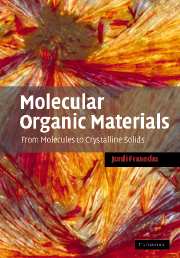Book contents
- Frontmatter
- Contents
- Preface
- List of abbreviations and symbols
- List of chemical abbreviations
- 1 An introduction to molecular organic materials
- 2 Building molecules: molecular engineering
- 3 Building materials: crystal engineering
- 4 Interfaces
- 5 Thin-film growth: from 2D to 3D character
- 6 A miscellany of physical properties
- Afterword
- Appendix A
- Appendix B
- References
- Index
2 - Building molecules: molecular engineering
Published online by Cambridge University Press: 23 November 2009
- Frontmatter
- Contents
- Preface
- List of abbreviations and symbols
- List of chemical abbreviations
- 1 An introduction to molecular organic materials
- 2 Building molecules: molecular engineering
- 3 Building materials: crystal engineering
- 4 Interfaces
- 5 Thin-film growth: from 2D to 3D character
- 6 A miscellany of physical properties
- Afterword
- Appendix A
- Appendix B
- References
- Index
Summary
Toute la nature est à mes ordres, nous répondit la Durand, et elle sera toujours aux volontés de ceux qui l'étudieront: avec la chimie et la physique on parvient à tout.
All of nature is at my command, replied Madame Durand, and she will always be at the will of those who study her: with chemistry and physics one can achieve anything.
Marquis de Sade, Histoire de JulietteStating that molecules constitute the most important part of MOMs seems superfluous since they are indeed their fundamental building blocks. However, since most of the attention and glory has been devoted to the properties of MOMs, from both the scientific and technological points of view, the first and indispensable step in the chain that leads to MOMs, that is the synthesis of the constituent molecules without which MOMs cannot be built, has somehow been ignored. For a layman in the domain of synthesis of organic molecules (and this is my case) it is certainly easy to fall under the wrong impression that almost any molecule can be synthesized, given the seemingly countless number of available molecules that can be found in the literature. However, the creation of new molecules is, as expected, a complex matter and we will see a revealing example in the following section, where it will become evident that only a limited number of linear acenes have been prepared.
- Type
- Chapter
- Information
- Molecular Organic MaterialsFrom Molecules to Crystalline Solids, pp. 85 - 101Publisher: Cambridge University PressPrint publication year: 2006

